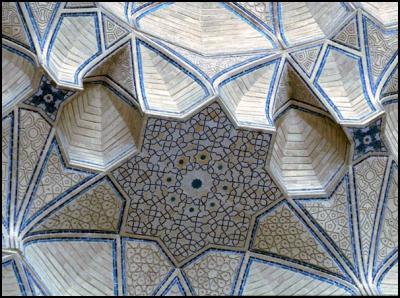You Mean Muslims Make Art?
You Mean Muslims Make Art?
By David Swanson
June 20, 2012
http://warisacrime.org/content/you-mean-muslims-make-art

Click for big version.
When Jesus used a good Samaritan to explain the need to appreciate foreigners, he can be forgiven for not having known that so many Samaritans would later convert to Islam. It's not as if he was omniscient or something! And think of how much he's forgiven us. Nonetheless, since we can't reasonably be expected to appreciate Muslims -- at least not while we're teaching young people that Muslims deserve genocide -- that whole parable falls apart.
I doubt one film can solve this problem, but I did just get a chance to preview a beautiful documentary that will be airing on PBS on July 6th, called "Islamic Art: Mirror of the Invisible World." Susan Sarandon narrates, and the voices are all in English -- no dubbing or subtitles. They're the voices of professors, art scholars, and artists. The subtitle could be a reference to cultures of the distant past, as an early comment in the film suggests, or perhaps it carries some sort of religious meaning.
The art in the film is largely but not exclusively religious. It's all art and architecture of "the Muslim world," taken to mean geographic areas dominated by Muslim culture now or in the past. We learn about the heavy use of Arabic writing in Islamic art, in calligraphy, and in architectural inscriptions. We tour great works of architecture in Palestine, Syria, Spain, Turkey, Mali, and India. In the secular world, apart from the mosques, we see plates, bowls, pitchers, sculptures, and paintings depicting animals and people.
In Isfahan, in the middle of Iran, so easily bombed, we find the origin of the blue and white ceramics we associate with a nation they spread to: China -- as well as stunning images of a beautiful blue mosque. During the course of the movie we are told how various Muslim art forms were influenced by Christian or Hindu art. And of course, the opposite has been just as common. The interlocking histories of these cultures make it very difficult to speak of one as if it were separate from the others.
I have to assume that someone who identified with a religion other than Islam could have as easy a time appreciating Islamic art as I do, being an atheist who would prefer to see the world leave religion behind. Some of the experts heard in the film instruct us that various art objects refer to prayer or heaven, or that the art provides the viewer with a religious experience. And yet if I ignore the commentary what I see are incredible designs and colors developed around natural and mathematical beauty.
God said: to know me, know my creations, we're told, and yet the flower designs woven into wonderful tapestries in Western Asia inspire even if I'm not trying to know something else that I can know by knowing them, if you know what I mean.
David Swanson's books include "War Is A Lie." He blogs at http://davidswanson.org and http://warisacrime.org and works for the online activist organization http://rootsaction.org. He hosts Talk Nation Radio. Follow him on Twitter: @davidcnswanson and Facebook.


 Gordon Campbell: On The Americanising Of NZ’s Public Health System
Gordon Campbell: On The Americanising Of NZ’s Public Health System Ian Powell: Trumpian Health Leadership
Ian Powell: Trumpian Health Leadership Eugene Doyle: Disruption - Historians Challenge Russophobic Propaganda
Eugene Doyle: Disruption - Historians Challenge Russophobic Propaganda Ramzy Baroud: War, Doublethink, And The Struggle For Survival - Geopolitics Of The Gaza Genocide
Ramzy Baroud: War, Doublethink, And The Struggle For Survival - Geopolitics Of The Gaza Genocide Binoy Kampmark: Authoritarian Politics - Netanyahu’s War On Israeli Institutions
Binoy Kampmark: Authoritarian Politics - Netanyahu’s War On Israeli Institutions Keith Rankin: Learning The Correct Lessons From World War Two In Europe
Keith Rankin: Learning The Correct Lessons From World War Two In Europe